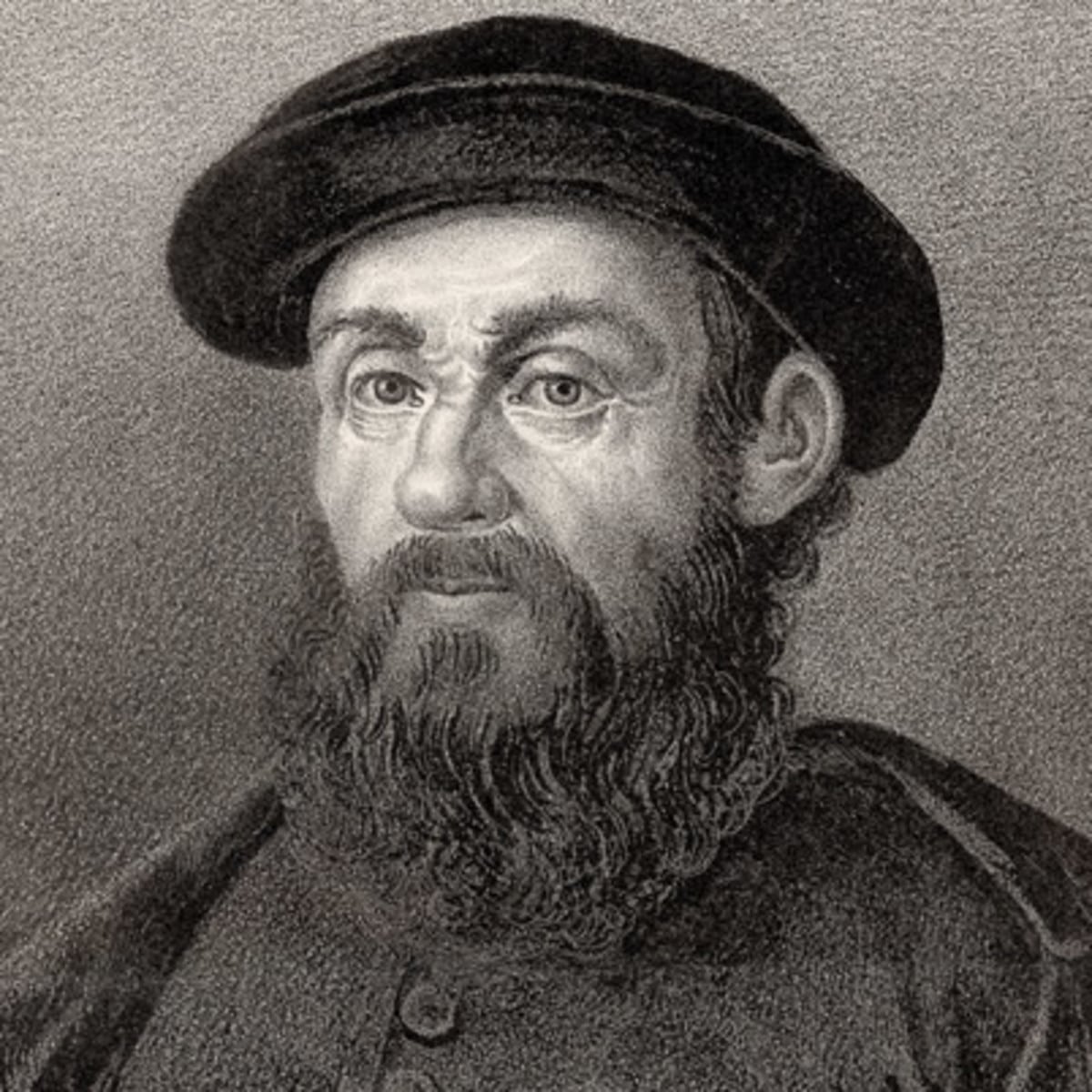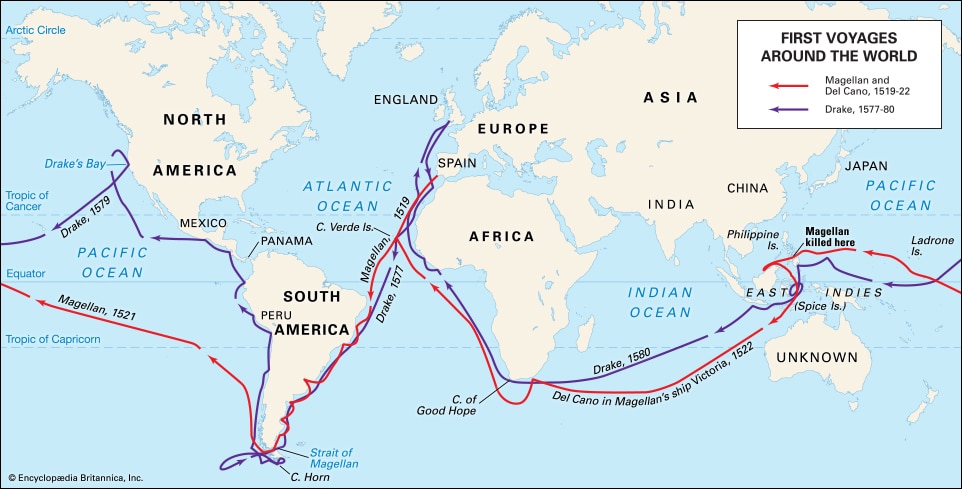Ferdinand Magellan (1480 – 27 April 1521) was born in Portugal in 1480 but would sail under the Spanish flag. His expedition would become the first to circumnavigate the earth, although he did not complete the voyage. Along the way, he discovered new islands, water passageways, and a new sea route to Asia. The sea route to Asia was accomplished by sailing around the South American continent. This would be the only way the West could travel to Asia by using the Western route until the Panama Canal was finished in 1914.
Jump to:
Early Career in Portugal

- Ferdinand Magellan was born around 1480 in Portugal. He would have been a young child when Bartolmeu Dias and Vasco da Gama discovered the eastern route around the tip of Africa.
- Magellan's parents were highly influential Portuguese citizens with claims to the Portuguese throne. They died when he was 10 years old.
- After their death, Queen Leonor made Magellan a page. He would stay a page until the age of 25, when he was sent as the first viceroy of Portuguese India. A post that he held for 8 years.
- While viceroy Ferdinand Magellan became an exceptional navigator and well-versed in naval warfare, he fought in multiple battles under the Portuguese flag, such as the Battle of Cannanore and the Battle of Diu.
- During the Battle of Diu, his skill earned him honors and a promotion. Shortly after his promotion, Magellan helped conquer Malacca. Ferdinand Magellan continued to serve the Portuguese Crown but fell out of favor with the King after being accused of illegally trading with the Moors.
- The accusations were proven to be false, but the stigma remained, and Magellan found it hard to find work as a Portuguese seaman. After arguing with King Manuel I, Magellan left Portugal and would not be seen again until he was sailing under the Spanish flag. He would devote himself to the study of the possibility of a new passageway to the East.
- While in Spain, Ferdinand Magellan befriended Diogo Barbosa and married his daughter. The couple would have two children, but neither would make it to adulthood. His unnamed wife would die in 1521.
Voyage of Circumnavigation
- In 1492, Ferdinand of Aragon and Isabel of Castile commissioned Christopher Columbus to find a western passage to Asia. Although he thought he had reached India, he had not, and it was confirmed by men such as Amerigo Vespucci and Vasco de Nunez Balboa.
- Even so, Spain's economy boomed with the New World's discovery, and new trade was established with new natural resources. The export of sugar became a wealthy commodity for the Spanish.
- A few short years afterward, the Portuguese established a lucrative spice trade with India through Vasco da Gama, who, along with Bartolomeu Dias, discovered the eastern route around the tip of Africa.
- With this discovery, the small nation of Portugal became a global economic powerhouse. The Portuguese never cared much about the New World, as their focus was primarily on the African coast and Asia.
- They did not have the military power to compete with nations such as France, Spain, England, or the Holy Roman Empire, but their economic strength made them a formidable enemy because they would be able to fund a defensive campaign.
- With the success of the Portuguese and a treaty signed between Portugal and Spain giving Portugal control of the eastern route, The Spanish looked for another route to get access to the riches of Asia. Ferdinand Magellan began researching possible ways around the southern tip of the New World and believed he had found a southwest passage to the New World.
- With this knowledge, he was granted an audience with King Charles I. King Charles showed great interest in the idea that Magellan presented. This would allow the Spanish to open up a spice route without damaging the relations with the neighboring Portuguese.
- Although Portugal's military was not nearly as strong as the Spanish Military, King Charles knew and understood the European Theatre. He would eventually become Emperor of the Holy Roman Empire and fight wars with England, France, and the Ottoman Empire. Avoiding conflict with Portugal would play to his advantage in years to come.
- King Charles agreed to fund them and granted them these five things:
- A monopoly of the discovered route for 10 years.
- 5% of the net gains in the land or islands he discovered
- 5th of the gains of travel.
- The right to levy 1,000 ducats on future trips and pay only 5% on the rest
- Granting an island to him that was not one of the six richest.
- Ferdinand Magellan's voyage was approved, and his fleet was ready by August 10, 1519.
- Upon learning of Magellan's voyage, King Manuel I sent a detachment to follow him, but it was to no avail. Magellan easily avoided them and sailed to the Canary Islands, where he stopped for a short period and then sailed to Cape Verde and then to Cape St. Augustine in Brazil.
- Magellan knew that Brazil was Portuguese territory, so he sailed past it and put his anchor down near Rio de Janeiro. After a delay due to inclement weather, he continued down the South American coast to find the strait that would lead them to the Eastern lands.
- They continued down the coast and established a settlement which they named Puerto San Julian.
- Magellan then faced some opposition as his crew mutinied against him. It was easily squashed, and the instigators were impaled on the coast. This would be confirmed when Sir Francis Drake of England circumnavigated the earth and found the bones of the mutinous crew on the coast.
- After putting down the riot, Magellan sent a small detachment under Duarte Barbosa to scout the southern coast. His ship was destroyed by a violent storm, but all the crew members survived. Magellan decided to wait to avoid the storms and then continued down the South American coast.
- On October 21, Ferdinand Magellan reached what would become known as the Strait of Magellan. This strait would take the crew around the tip of South America and into the east. Magellan would continue northwest to find the wealth of Asia and establish a Spanish spice route. Along the way, he looked for new lands and islands.
- Magellan reached the equator on February 13, 1521, and soon after came across the islands of Marianas and Guam. On March 17, 1521, Magellan reached the Philippine archipelago.
- He and his Spaniards went ashore to meet the natives, and to their shock, they were not the first Europeans to make it to the Philippines. The Portuguese had begun trading with the natives during the time between Magellan's banishment from King Manuel's court and King Charles' funding of Magellan's voyage.
Death of Ferdinand Magellan
- Ferdinand Magellan came in contact with the native tribes of Cebu and was able to communicate with them through his interpreter Enrique, who had been indentured to him in 1511 while Magellan was still sailing for Portugal.
- The leader of Cebu, Rajah Humabon, was friendly towards Magellan and his crew. Rajah and his queen had been converted to Christianity by the Europeans, which aided Magellan's relations with them.
- After much talk, Rajah Humabon, along with his ally Data Zula, enlisted the help of Magellan to kill their enemy based in Lapu-Lapu. Magellan did not want to immediately attack them but first wanted to try to convert them to Christianity. When those efforts failed, he organized an attack force and marched on the coast of Lapu-Lapu.
- The battle marked the end of Ferdinand Magellan's voyage as he was surrounded by the Lapu-Lapu and speared to death.
- The voyage continued without him, and the surviving men sailed throughout the east and around the coast of Africa and into the Spanish harbor.
- The survivors managed to trade a bit with the East, but little was accomplished. Magellan's voyage can be viewed as a success in reconnaissance but a failure in established a spice route. The Spanish would eventually establish trade with the East, but it would be with their New World colonies.

Online Resources
- Wikipedia - Ferdinand Magellan
- Age of Exploration - Ferdinand Magellan Biography
- Royal Museums Greenwich
- Journal of Magellan's Voyages
- Eyewitness to History - Death of Magellan
- Over The Edge of the World
- The History Junkie's Guide to Famous Explorers
- The History Junkie's Guide to European Colonization
